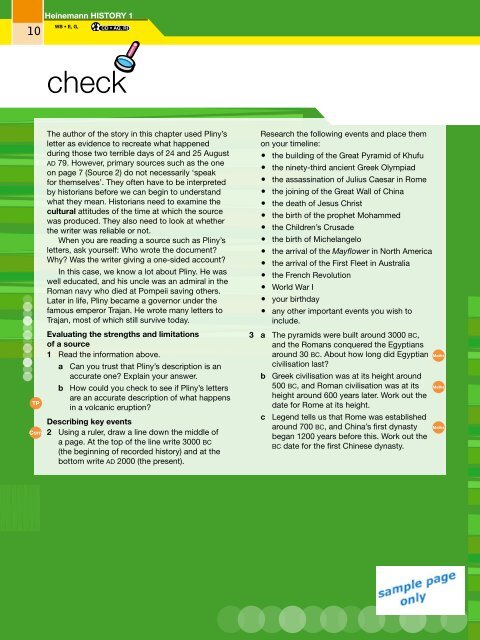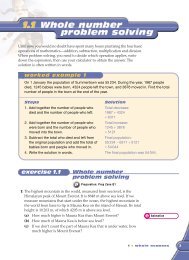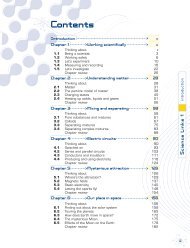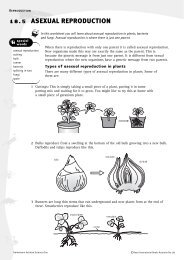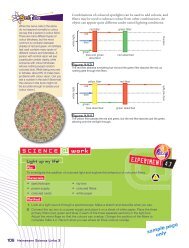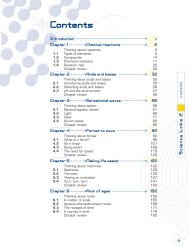Heinemann HISTORY 1 The author of the story in this chapter used ...
Heinemann HISTORY 1 The author of the story in this chapter used ...
Heinemann HISTORY 1 The author of the story in this chapter used ...
Create successful ePaper yourself
Turn your PDF publications into a flip-book with our unique Google optimized e-Paper software.
10<br />
<strong>He<strong>in</strong>emann</strong> <strong>HISTORY</strong> 1<br />
WB • E, G, CD • AQ, RI<br />
check<br />
TP<br />
Com<br />
<strong>The</strong> <strong>author</strong> <strong>of</strong> <strong>the</strong> <strong>story</strong> <strong>in</strong> <strong>this</strong> <strong>chapter</strong> <strong>used</strong> Pl<strong>in</strong>y’s<br />
letter as evidence to recreate what happened<br />
dur<strong>in</strong>g those two terrible days <strong>of</strong> 24 and 25 August<br />
ad 79. However, primary sources such as <strong>the</strong> one<br />
on page 7 (Source 2) do not necessarily ‘speak<br />
for <strong>the</strong>mselves’. <strong>The</strong>y <strong>of</strong>ten have to be <strong>in</strong>terpreted<br />
by historians before we can beg<strong>in</strong> to understand<br />
what <strong>the</strong>y mean. Historians need to exam<strong>in</strong>e <strong>the</strong><br />
cultural attitudes <strong>of</strong> <strong>the</strong> time at which <strong>the</strong> source<br />
was produced. <strong>The</strong>y also need to look at whe<strong>the</strong>r<br />
<strong>the</strong> writer was reliable or not.<br />
When you are read<strong>in</strong>g a source such as Pl<strong>in</strong>y’s<br />
letters, ask yourself: Who wrote <strong>the</strong> document?<br />
Why? Was <strong>the</strong> writer giv<strong>in</strong>g a one-sided account?<br />
In <strong>this</strong> case, we know a lot about Pl<strong>in</strong>y. He was<br />
well educated, and his uncle was an admiral <strong>in</strong> <strong>the</strong><br />
Roman navy who died at Pompeii sav<strong>in</strong>g o<strong>the</strong>rs.<br />
Later <strong>in</strong> life, Pl<strong>in</strong>y became a governor under <strong>the</strong><br />
famous emperor Trajan. He wrote many letters to<br />
Trajan, most <strong>of</strong> which still survive today.<br />
Evaluat<strong>in</strong>g <strong>the</strong> strengths and limitations<br />
<strong>of</strong> a source<br />
1 Read <strong>the</strong> <strong>in</strong>formation above.<br />
a Can you trust that Pl<strong>in</strong>y’s description is an<br />
accurate one? Expla<strong>in</strong> your answer.<br />
b How could you check to see if Pl<strong>in</strong>y’s letters<br />
are an accurate description <strong>of</strong> what happens<br />
<strong>in</strong> a volcanic eruption?<br />
Describ<strong>in</strong>g key events<br />
2 Us<strong>in</strong>g a ruler, draw a l<strong>in</strong>e down <strong>the</strong> middle <strong>of</strong><br />
a page. At <strong>the</strong> top <strong>of</strong> <strong>the</strong> l<strong>in</strong>e write 3000 bc<br />
(<strong>the</strong> beg<strong>in</strong>n<strong>in</strong>g <strong>of</strong> recorded hi<strong>story</strong>) and at <strong>the</strong><br />
bottom write ad 2000 (<strong>the</strong> present).<br />
Research <strong>the</strong> follow<strong>in</strong>g events and place <strong>the</strong>m<br />
on your timel<strong>in</strong>e:<br />
• <strong>the</strong> build<strong>in</strong>g <strong>of</strong> <strong>the</strong> Great Pyramid <strong>of</strong> Khufu<br />
• <strong>the</strong> n<strong>in</strong>ety-third ancient Greek Olympiad<br />
• <strong>the</strong> assass<strong>in</strong>ation <strong>of</strong> Julius Caesar <strong>in</strong> Rome<br />
• <strong>the</strong> jo<strong>in</strong><strong>in</strong>g <strong>of</strong> <strong>the</strong> Great Wall <strong>of</strong> Ch<strong>in</strong>a<br />
• <strong>the</strong> death <strong>of</strong> Jesus Christ<br />
• <strong>the</strong> birth <strong>of</strong> <strong>the</strong> prophet Mohammed<br />
• <strong>the</strong> Children’s Crusade<br />
• <strong>the</strong> birth <strong>of</strong> Michelangelo<br />
• <strong>the</strong> arrival <strong>of</strong> <strong>the</strong> Mayflower <strong>in</strong> North America<br />
• <strong>the</strong> arrival <strong>of</strong> <strong>the</strong> First Fleet <strong>in</strong> Australia<br />
• <strong>the</strong> French Revolution<br />
• World War I<br />
• your birthday<br />
• any o<strong>the</strong>r important events you wish to<br />
<strong>in</strong>clude.<br />
3 a <strong>The</strong> pyramids were built around 3000 bc,<br />
and <strong>the</strong> Romans conquered <strong>the</strong> Egyptians<br />
around 30 bc. About how long did Egyptian<br />
civilisation last?<br />
b Greek civilisation was at its height around<br />
500 bc, and Roman civilisation was at its<br />
height around 600 years later. Work out <strong>the</strong><br />
date for Rome at its height.<br />
c Legend tells us that Rome was established<br />
around 700 bc, and Ch<strong>in</strong>a’s first dynasty<br />
began 1200 years before <strong>this</strong>. Work out <strong>the</strong><br />
bc date for <strong>the</strong> first Ch<strong>in</strong>ese dynasty.<br />
Maths<br />
Maths<br />
Maths
Chapter 1 POMPEII: <strong>in</strong>terpret<strong>in</strong>g <strong>the</strong> past<br />
11<br />
How long ago?<br />
Hi<strong>story</strong> can be divided <strong>in</strong>to four ma<strong>in</strong> periods that<br />
stretch back thousands <strong>of</strong> years.<br />
Period<br />
Prehistoric times<br />
Date bc (before Christ or ad<br />
(after Christ)<br />
Before c. 3000 bc — no<br />
written records exist although<br />
<strong>the</strong>re were visual records such<br />
as pa<strong>in</strong>t<strong>in</strong>gs and <strong>in</strong>formation<br />
was also passed on orally (by<br />
mouth)<br />
Ancient hi<strong>story</strong> c. 3000 bc to ad 500<br />
Middle Ages c. ad 500 to ad 1500<br />
Modern hi<strong>story</strong><br />
c. ad 1500 to <strong>the</strong> present<br />
<strong>The</strong> Pompeii <strong>story</strong> is based on two dates, one<br />
ancient and <strong>the</strong> o<strong>the</strong>r modern: <strong>the</strong> eruption <strong>of</strong> Mt<br />
Vesuvius <strong>in</strong> ad 79, and <strong>the</strong> excavation <strong>of</strong> Pompeii<br />
<strong>in</strong> 1863.<br />
Note:<br />
• BC means ‘before Christ’; AD stands for <strong>the</strong><br />
Lat<strong>in</strong> term ‘Anno Dom<strong>in</strong>i’ (Year <strong>of</strong> our Lord) and<br />
refers to <strong>the</strong> time after Christ’s death.<br />
• <strong>The</strong> abbreviation ‘c.’ <strong>in</strong> front <strong>of</strong> a date means<br />
‘circa’, or approximately.
<strong>He<strong>in</strong>emann</strong> <strong>HISTORY</strong> 1<br />
12<br />
WB • F, H, I, J CD • FG, MG, MC<br />
TRK • EW, EW, CT, AT<br />
glossary<br />
aqueduct man-made structure that carried water<br />
from mounta<strong>in</strong> streams to towns<br />
artefact a human-created object, small or large,<br />
such as a tool or a build<strong>in</strong>g<br />
archaeologist someone who uses scientific<br />
methods to uncover <strong>the</strong> past<br />
basilica a large church or temple, <strong>of</strong>ten built with<br />
rows <strong>of</strong> columns<br />
cultural relat<strong>in</strong>g to <strong>the</strong> lifestyle <strong>of</strong> a group <strong>of</strong> people<br />
at a given time<br />
lava molten rock erupt<strong>in</strong>g from beneath <strong>the</strong> Earth’s<br />
surface<br />
Jupiter <strong>the</strong> chief god <strong>of</strong> <strong>the</strong> Romans<br />
primary source evidence from <strong>the</strong> time <strong>of</strong> <strong>the</strong><br />
event, such as an eyewitness account, or an<br />
object, build<strong>in</strong>g, or skeletal rema<strong>in</strong>s<br />
pumice molten rock which is filled with air as it is<br />
blasted <strong>in</strong>to <strong>the</strong> sky<br />
secondary source evidence such as a book or<br />
pa<strong>in</strong>t<strong>in</strong>g created after <strong>the</strong> time <strong>of</strong> an event, by<br />
someone not at <strong>the</strong> event<br />
sibyl a woman <strong>in</strong> ancient times who was believed<br />
to be a mouthpiece <strong>of</strong> <strong>the</strong> gods<br />
Temple <strong>of</strong> Venus a large temple <strong>in</strong> Pompeii<br />
dedicated to <strong>the</strong> Roman goddess Venus<br />
Vesta Roman goddess <strong>of</strong> <strong>the</strong> fireplace, who<br />
watched over <strong>the</strong> family<br />
Vulcan Roman god <strong>of</strong> fire


